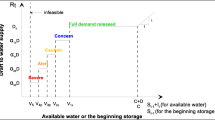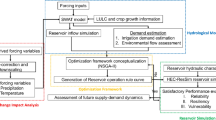Abstract
For an effective reservoir operation during drought, the variations of both water supply and water demand which depend on hydrological and meteorological conditions need to be dealt with. This paper aimed to consider these variations in the Aharchay basin (Iran) by coupling a hedging rule (HR)-based reservoir operation model (HRROM) with a climate-based irrigation scheduling model (CBISM) at the farm level. Through the HRROM, optimal long-term decisions for Sattarkhan reservoir were made by considering the probable streamflow scenarios in the system. Given the variable agricultural demands (VAD) in the CBISM, the irrigation water was optimally allocated to the crops using several evapotranspiration (ET) scenarios. The CBISM employs three sub-models including linear programming (LP), nonlinear programming (NLP), and particle swarm optimization (PSO) to maximize the total income of the Aharchay agricultural network as a function of the climate factors and the supplied water. To this end, the daily weather and discharge data from 1990 to 2015 were used in this study. The standardized precipitation-evapotranspiration index (SPEI) and the streamflow drought index (SDI) were used to detect the meteorological and hydrological droughts, respectively. The SPEI was calculated based on the high-resolution-gridded datasets of the Climatic Research Unit (CRU). The findings demonstrated that the HRROM-CBISM generally managed to increase the time-based (αt) and volume-based (αv) reliability indices by 20% and 44%, respectively, compared with the conventional standard operation policy (SOP). For more investigations, the three major droughts of 2000–2002, 2004–2006, and 2008–2014 were separately analyzed. The average values of αt, αv, and vulnerability (V) for SOP were 0.33, 0.51, and 0.48, respectively. With the HRROM-CBISM, these values were about 0.5, 0.55, and 0.45, respectively. Among these indices, αt had the highest variations, while αv had the lowest variations in both the SOP and HRROM-CBISM approaches. The average water shortage for the mentioned droughts was significantly decreased from 89 (SOP) to 75 MCM (HRROM-CBISM).












Similar content being viewed by others
References
Adeloye AJ, Soundharajan BS, Ojha CS, Remesan R (2016) Effect of hedging-integrated rule curves on the performance of the pong reservoir (India) during scenario-neutral climate change perturbations. Water Resour Manag 30(2):445–470
Ahmad MI, Sinclair CD, Werritty A (1988) Log-logistic flood frequency analysis. J Hydrol 98(3-4):205–224
Akay B (2013) A study on particle swarm optimization and artificial bee colony algorithms for multilevel thresholding. Appl Soft Comput 13:3066–3091
Allen RG, Pereira LS, Raes D, Smith M (1998) Crop evapotranspiration – guidelines for computing crop water requirements. FAO Irrigation and Drainage Paper 56, FAO, p 1998 ISBN 92-5-104219
Anvari S, Mousavi SJ, Morid S (2014) Sampling/stochastic dynamic programming for optimal operation of multi-purpose reservoirs using artificial neural network-based ensemble streamflow predictions. J Hydroinf 16(4):907–921
Anvari S, Kim JH, Moghaddasi M (2019) The role of meteorological and hydrological uncertainties in the performance of optimal water allocation approaches. Irrig Drain 68(2):342–353
Bayazit M, Unal E (1990) Effects of hedging on reservoir performance. Water Resour Res 26(4):713–719
Chang J, Guo A, Wang Y, Ha Y, Zhang R, Xue L, Tu Z (2019) Reservoir operations to mitigate drought effects with a hedging policy triggered by the drought prevention limiting water level. Water Resour Res 55(2):904–922
Clarke D, Smith M, El-Askari K (2001) CropWat for Windows: user guide. IHE, Oak Brook, IL, USA
Delavar M, Moghadasi M, Morid S (2012) Real-time model for optimal water allocation in irrigation systems during droughts. J Irrig Drain Eng 138(6):517–524
Draper AJ, Lund JR (2004) Optimal hedging and carryover storage value. J Water Resour Plan Manag 130(1):83–87
Eum H, Kim YO, Palmer R (2011) Optimal drought management using sampling stochastic dynamic programming with a hedging rule. J Water Resour Plan Manag 137(1):113–122
Ghodousi H, Sadaat Morsali S (2016) Application of linear programming for crop pattern optimization of Aharchay basin in existing and development conditions, pp 248–255
Hashimoto T, Stedinger JR, Loucks DP (1982) Reliability, resilience, and vulnerability criteria for water resource system performance evaluation. Water Resour Res 18(1):14–20
Ji Y, Lei X, Cai S, Wang X (2016) Hedging rules for water supply reservoir based on the model of simulation and optimization. Water 8(6):249
Karamouz M, Imen S, Nazif S (2012) Development of a demand driven hydro-climatic model for drought planning. Water Resour Manag 26(2):329–357
Karamouz M, Ahmadi B, Zahmatkesh Z (2013) Developing an agricultural planning model in a watershed considering climate change impacts. J Water Resour Plan Manag 139(4):349–363
Kim YO, Eum H, Lee EG, Ko IH (2007) Optimizing operational policies of a Korean multi-reservoir system using sampling stochastic dynamic programming with ensemble streamflow prediction. J Water Resour Plan Manag 133(1):4–14
Kumar DN, Raju KS, Ashok B (2006) Optimal reservoir operation for irrigation of multiple crops using genetic algorithms. Journal of Irrigation and Drainage Engineering Engineering (ASCE) 132(2):123–129
Labadie JW (2004) Optimal operation of multi-reservoir systems: state-of-the-art review. J Water Resour Plan Manag 130(2):93–111
Lee S, Jin Y, Park J (2017) Comparison of hedging rule curves depending on available water and current storage in reservoir operation under droughts. European Water 60:227–232
Loucks DP, Stedinger JR, Haith DA (1981) Water resources systems planning and analysis. Prentice-Hall, Englewood Cliffs, N. J.
McKee TB, Doesken NJ, Kleist J (1993) The relationship of drought frequency and duration to time scales. American Meteorological Society. 8th Conference on Applied Climatology, 17–22 Janvier, Anaheim, California, Boston, MA: American, pp 179–184
Men B, Wu Z, Li Y, Liu H (2019) Reservoir operation policy based on joint hedging rules. Water 11(3):419. https://doi.org/10.3390/w11030419
Moghaddasi M, Araghinejad S, Morid S (2010a) Long-term operation of irrigation dams considering variable demands: case study of Zayandeh-rud reservoir, Iran. J Irrig Drain Eng 136(5):309–316
Moghaddasi M, Morid S, Araghinejad S, Alikhani MA (2010b) Assessment of irrigation water allocation based on optimization and equitable water reduction approaches to reduce agricultural drought losses: the 1999 drought in the Zayandeh Rud irrigation system (Iran). Irrigation and drainage (ICID) 59(4):377–387
Moghaddasi M, Anvari S, Mohammadi T (2022b) Comparison of extreme value theory approaches in temperature frequency analysis (case study: Arak plain in Iran). Arab J Geosci 15(12):1–13
Mutti PR, Dubreuil V, Bezerra BG, Arvor D, de Oliveira CP, Santos e Silva, C. M. (2020) Assessment of gridded CRU TS data for long-term climatic water balance monitoring over the São Francisco Watershed. Brazil Atmosphere 11(11):1207
Naderi K, Moghaddasi M, shokri, A. (2022) Drought occurrence probability analysis using multivariate standardized drought index and copula function under climate change. Water Resour Manag 36:2865–2888. https://doi.org/10.1007/s11269-022-03186-1
Nalbantis I, Tsakiris G (2009) Assessment of hydrological drought revisited. Water Resour Manag 23(5):881–897
Neelakantan TR, Pundarikanthan NV (1999) Hedging rule optimization for water supply reservoirs system. Water Resour Manag 13(6):409–426
Ranjbar N, Anvari S, Delavar M (2021) The application of harmony search and genetic algorithms for the simultaneous optimization of integrated reservoir–FARM systems (IRFS). https://doi.org/10.1002/ird.2567
Sasireka K, Neelakantan TR (2017) Optimization of hedging rules for hydropower reservoir operation. Scientia Iranica 24(5):2242–2252
Shiau JT (2009) Optimization of reservoir hedging rules using multi-objective genetic algorithm. J Water Resour Plan Manag 135(5):355–363
Shih JS, ReVelle C (1994) Water-supply operations during drought: continuous hedging rule. J Water Resour Plan Manag 120(5):613–629
Soundharajan BS, Adeloye AJ, Remesan R (2016) Evaluating the variability in surface water reservoir planning characteristics during climate change impacts assessment. J Hydrol 538(10):625–639
Spiliotis M, Mediero L, Garrote L (2016) Optimization of hedging rules for reservoir operation during droughts based on particle swarm optimization. Water Resour Manag 30:5759–5778
Srinivasan K, Kumar K (2018) Multi-objective simulation-optimization model for long-term reservoir operation using piecewise linear hedging rule. Water Resour Manag 32:1901–1911
Srinivasan K, Philipose MC (1998) Effect of hedging on over-year reservoir performance. Water Resour Manag 12(2):95–120
Taghian M, Rosbjerg D, Haghighi A, Madsen H (2014) Optimization of conventional rule curves coupled with hedging rules for reservoir operation. J Water Resour Plan Manag 140(5):693–698
Vicente-Serrano SM, Begueria S, Lopez-Moreno JI (2010) A multi-scalar drought index sensitive to global warming: the standardized precipitation evapotranspiration index - SPEI. J Clim 23:1696–1718. https://doi.org/10.1175/2009JCLI2909.1
Wurbs R (1993) Reservoir-system simulation and optimization models. J Water Resour Plan Manag 119(4):455–472
Yeh WWG (1985) Reservoir management and operations models: a state of-the-art review. Water Resour Res 21(12):1797–1818
Anvari S, Mousavi, S.J, Morid, S. (2017). Stochastic dynamic programming-based approach for optimal irrigation scheduling under restricted water availability conditions. Irrig Drain, 66(4), 492-500. https://doi.org/10.1002/ird.2130.
Doorenbos J, Kassam AH (1979) Yield response to water. In: Irrigation and Drainage. Paper 33. FAO, Rome. Italy
McKee TB, Doesken NJ, Kleist J (1995) Drought monitoring with multiple time scales. In: 482 9th Conference on Applied Climatology, American Meteorological Society 233-236
Moghaddasi M, Anvari S, Akhondi N (2022a) A trade-off analysis of adaptive and non-adaptive future optimized rule curves based on simulation algorithm and hedging rules. Theor Appl Climatol 148(65-78)
Shiau JT (2011) Analytical optimal hedging with explicit incorporation of reservoir release and carryover storage targets. Water Resour Res 47(1). https://doi.org/10.1029/2010WR009166
You JY, Cai X (2008a) Hedging rule for reservoir operations: 1. A theoretical analysis. Water Resour Res 44(1). https://doi.org/10.1029/2006WR005482
You JY, Cai X (2008b) Hedging rule for reservoir operations: 2. A numerical model. Water Resour Res 44(1). https://doi.org/10.1029/2006WR005481
Acknowledgements
This research work was supported by the Graduate University of Advanced Technology (Institute of Science and High Technology and Environmental Science) (No. 97/2659). The authors gratefully acknowledge this help.
Data availability
Available on request
Code availability
The software used in this research will be available (by the corresponding author) upon reasonable request.
Author information
Authors and Affiliations
Contributions
Sedigheh Anvari and Mahnoosh Moghaddasi: Conceptualization, methodology, technical investigation, writing, reviewing and editing, visualization, supervision, software, data curation, validation, editing. Mohammad Hossein Bagheri: Data collection
Corresponding author
Ethics declarations
Ethical approval
This is not applicable because this article does not contain any studies with human or animal subjects.
Consent to participate
The research data were not prepared through a questionnaire.
Consent for publication
There is no conflict of interest regarding the publication of this article.
Conflict of interest
The authors declare no competing interests.
Additional information
Publisher’s note
Springer Nature remains neutral with regard to jurisdictional claims in published maps and institutional affiliations.
Supplementary information
ESM 1:
(PDF 1897 kb)
Rights and permissions
Springer Nature or its licensor (e.g. a society or other partner) holds exclusive rights to this article under a publishing agreement with the author(s) or other rightsholder(s); author self-archiving of the accepted manuscript version of this article is solely governed by the terms of such publishing agreement and applicable law.
About this article
Cite this article
Anvari, S., Moghaddasi, M. & Bagheri, M.H. Drought mitigation through a hedging-based model of reservoir-farm systems considering climate and streamflow variations. Theor Appl Climatol 152, 723–737 (2023). https://doi.org/10.1007/s00704-023-04402-7
Received:
Accepted:
Published:
Issue Date:
DOI: https://doi.org/10.1007/s00704-023-04402-7




